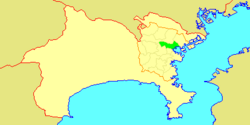Kanagawa-ku
|
Kanagawa 神奈川区 |
||
|---|---|---|
| Ward | ||
| Kanagawa Ward | ||
|
||
 Location of Kanagawa in Kanagawa |
||
| Coordinates: 35°28′37″N 139°37′46″E / 35.47694°N 139.62944°ECoordinates: 35°28′37″N 139°37′46″E / 35.47694°N 139.62944°E | ||
| Country | Japan | |
| Region | Kantō | |
| Prefecture | Kanagawa | |
| City | Yokohama | |
| Area | ||
| • Total | 23.88 km2 (9.22 sq mi) | |
| Population (February 2010) | ||
| • Total | 230,401 | |
| • Density | 9,650/km2 (25,000/sq mi) | |
| Time zone | Japan Standard Time (UTC+9) | |
| - Tree | Magnolia kobus | |
| - Flower | Tulip | |
| Address | 3-8 Hirodaiota-chō, Kanagawa-ku Yokohama-shi, Kanagawa-ken 221-0824 |
|
| Website | Kanagawa Ward Office | |
Kanagawa-ku (神奈川区?) is one of the 18 wards of the city of Yokohama in Kanagawa Prefecture, Japan. As of 2010, the ward had an estimated population of 230,401 and a density of 9,650 persons per km². The total area was 23.88 km².
Kanagawa is located in eastern Kanagawa Prefecture, and northeast of the geographic center of the city of Yokohama.
Under the Nara period Ritsuryō system, the area that is now Kanagawa Ward became part of Tachibana District in Musashi Province. During the Edo Period, the area was tenryō territory controlled directly by the Tokugawa shogunate, but administered through various hatamoto. The area prospered in the Edo period as Kanagawa-juku, a post station on the Tōkaidō connecting Edo with Kyoto. During the Bakumatsu period, Kanagawa was the location of the signing of the Convention of Kanagawa, which ended Japan’s national isolation policy and led to the normalization of diplomatic relations between the United States and Japan. The subsequent Treaty of Amity and Commerce (United States–Japan) led to the establishment of a treaty port for foreign commerce and settlement, which was initially stipulated to be Kanagawa. However, for security reasons, the actual settlement was established at neighboring Yokohama (present day Naka Ward). The Namamugi Incident, which led to the 1863 Anglo-Satsuma War, occurred in Kanagawa.
...
Wikipedia


